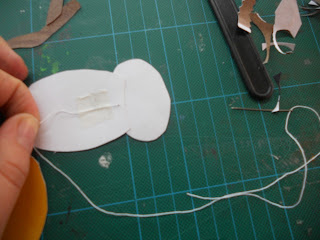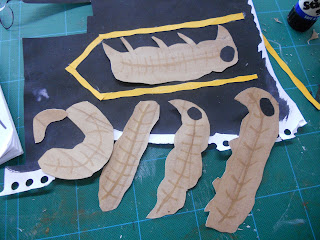First attempt with audio however the quality wasn't grand. Fuzziness in the background and then I think timing wise, it will be far easier to animate first and then voice over the animation.
Friday, 27 April 2012
Tester Animation Queen Bee
Scanned in all my Bees piece by piece as the stitched bees created a more jittery animation. To make it smoother each movement is now created through the use of anchor points and parenting in after effects. I created a short animation of the Queen bee moving. By making her return to her original position at the end of the short sequence I was able to loop this without having her jump out of place. The same sequence has been looped to create the Queens repetitive movement.
Editing in after effects
Tester Animation
I had to make sure the mirrored legs rotated at similar degrees. Also the wings, so they move symmetrically.
I made all the backgrounds of the images blue in order to enable me to use keying effects. The blue backgrounds acted in the same way that a green screen would have, after using the keying effects only the sections of the bee were visible.
Videos for reference
http://www.youtube.com/watch?v=x7cX2cjFunw&NR=1&feature=endscreen
Taking a closer look at how bees actually move.
Sesame street videos. Interesting that they use a childs voice for the narration. I suppose to a child ti would seem more like a peer speaking to them than an older person (ie teacher figure)
I find the sound track quite scary though.. alarming.
A cool approach to an educational video.
Wednesday, 25 April 2012
Making more Bees
After deciding upon a final wing template I cut out many sets to use for my bees.
Creating the template for the Queen bee from a birds eye view, made sure that she was larger than the worker bee and that the wings were in proportion to the bee.
Cut her out and used the stencil on my inked papers in order to get the correct shapes.
Crinkle cut scissors were brilliant for make the stripes for my bee.
Just had to scalpel away the edges
Three sections made, head, thorax and abdomen. I gave the queen bee a different coloured head to the worker and drone bee in order to make her more distinguishable.
In order to keep the pieces together I stitched them, however I still anted them to be moveable so I used masking tape to cover the ends of the thread.
The finished Queen
A closer look at all the taped sections
Creating a template for a birds eye view worker bee. She is slightly smaller than the Queen. I used the same leg stencils from the Queen bee for the worker.
The completed worker bee.
Two worker bees and the Queen
A final drone bee. He is bulkier than the worker bee and has a different back marking and one less stripe to differentiate from the worker bee.
Egg, larvae and pupae stages inside a cell. For demonstrating the development from egg to full grown bee.
Monday, 23 April 2012
Script
I cracked on with a script because then I know the structure for the animation. Therefore my can properly sort out my story board. I wanted a male voice for the narration so I had my friend on architecture do the voice for me. The first recording was a bit fuzzy, so a re-sit is going to happen. I couldn't fit all the facts and figures about bees into a short animation, simply the recording of the voice over was more than four minutes so I'm going to have to animate like a mad woman. If I were to make an animation featuring all the information I had collated from the books previously mentioned in this blog I could have gone on for well over half an hour. I was wondering whether to include more humour, to make the animation more engaging, but then again, I don't want to complicate things too much. Just worried the visuals will be too repetitive, being the inside of the hive and a lot of bees wiggling about on the screen. Going to try and over come this with varied settings and backgrounds. Playing with colour perhaps?
SCRIPT:
SCRIPT:
There are many different types of Bee, but perhaps the most fascinating of all is
the honey bee. And not simply because it makes honey, which is quite delicious.
There is much more to this insect than meets the eye.
Bees are incredibly busy insects and work
up to eight hours a day during the spring and summer to make honey. There are
three different ranks of honeybee, workers drones and the queen. The ones that
collect nectar to make the honey are worker bees. They begin this job at only
three weeks old.
This honey bee began her life in a beehive
which contains 50,000 to 100,000 bees.
The queen bee lays tiny white eggs inside
the beehive, around 1,500 everyday during the spring and summer, She lays these
eggs in cell chambers.
Most of the eggs that hatch will become
worker bees. These are all female. The other eggs become male and these are
called drones. A drone’s only job in it’s life is to mate with the queen, he
does no other work at all. After a drone has mated with the queen he dies.
The egg develops into a larva, which is fed
royal jelly, this comes out of a gland from a worker bees head. When the larva
is 3 days old the worker bee starts feeding it beebread, a mixture of honey and
pollen.
Once the larva is five days old the worker
bees will seal the cell with wax. The larva then covers herself with a cocoon,
and becomes a pupa. For the next three weeks the Pupa will transform and change
until she has become a full grown bee!
She then bites her way through the wax seal
on her cell and begins to clean the hive. The queen will not lay eggs in a
dirty cell so the worker bees get rid of leftover bits of wax, cocoon and dirt
from the empty cells. They get rid of these things by eating it!
It takes between 15 and 30 bees 40 minutes
to clean a cell.
So for the first three days of a bees life
she cleans, and cleans and cleans.
After that she feeds the larvae and checks
them. Nurse bees check on each larva more than a thousand times a day.
The bees body then begins producing wax, it
comes from the glands within a bees abdomen. She uses this wax to build the
cells in which the queen lays her eggs. Though some of the cells will be used
to store honey. This is called honeycomb. These cells are tilted so the honey
doesn’t drip out.
The bees then take care of the queen by
cleaning her, carrying away her waste, grooming her and even gathering around
her with other worker bees and flapping their wings to cool her off.
Soon the worker bee stops making as much
wax. Her new main job is to unload the nectar other bees bring to the hive. She
will eat some of it and store the rest in the honey cells.
She begs the other bees for the nectar by
beating her antennae against the antennae for the bee that has been out
collecting nectar. She puts her tongue into the bee’s mouth and eats the nectar
that the other bee regurgitates. This nectar is stored in the bees honey
stomach. Which is separate from her other stomach.
A bee’s body has three different sections,
it’s head, its thorax, and it’s abdomen.
Each part of a bee though has a special
function that helps them do their work. The bees eye can track the position of
the sun and uses this to navigate to flowers and back to the hive. Their wings
enable them to fly. Their hind leg has a pollen basket that stores pollen
collected from flowers. It also has a pollen brush which rubs pollen from one
plant, onto others as the bee travels from flower to flower. This pollenates the
flower. The bee also has a stinger for defense.
When a worker bee is just over two weeks
old she begins to guard the hive. Guard bees stay at the entrance of the hive
and protect the colony from wasps, animals, and other bees who would try to
steal the honey!
Guard bees recognize bees from their hive
because of their smell. The queens smell and taste is passed from bee to bee
when they pass on food, therefore all the bees from the same colony smell the
same.
A bee will defend against animals by using
her stinger, this sting stays in the animals skin and part of her insides also
stay there. Once a bee has stung it will die. The smell given off by a bee’s
sting is similar to that of a banana. Other bees are drawn to this smell and
try to stink in the same area.
When the bee is three weeks old it begins
collecting nectar. She lands on a plant and sucks the nectar through her
proboscis, a long flexible tube on her head. She collects as much as she can
carry and then flies back to the hive. This nectar is brought back to the hive
where other worker bees will store it in honey cells. The water in the nectar
evaporates and this makes the nectar become thick. It becomes honey.
A worker bee lives for about six weeks in
the spring and summer. Three of those weeks are spent gathering nectar, making
about 400 trips. She only makes about seven grams of honey in her life!
So when you next taste some delicious
honey, remember the honey bee and how hard it has worked to make it!
Tessa Farmer
Having a look at Tessa Farmers work. It is quite surreal, turning the typical fairy world on its head. The work to me, feels almost Victorian in the way it appears like a catalogue of species.
Thursday, 19 April 2012
Backgrounds
Collected various textures, used them in the layering of images below to create possible backgrounds for end credits? Just an idea.
Bees Wings
Stitched the bee together so that all the parts are together but moveable.
cut out various different designs for the wings,
Using the wing as a stencil so I can make a copy
A completed bee!
Paper Cut out Bees
A few pictures of the bee's I have been cutting out. They are in pieces because piece by piece the image can be moved on after effects which really speeds up the process of animating compared to stop frame animation.
Inked up a load of papers.
Basic idea for all the parts of a bee
So, time to cut out the template
First try out how it looks with acrylics
Using the template as a stencil for my inked up pages
I think I prefer this outcome to the acrylic one. It's more precise.
Then added details, stripes, stinger, eye.
Subscribe to:
Comments (Atom)





















































